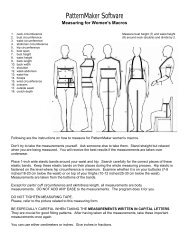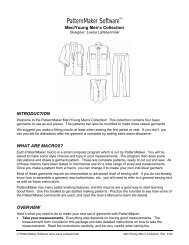PatternMaker Software
PatternMaker Software
PatternMaker Software
Create successful ePaper yourself
Turn your PDF publications into a flip-book with our unique Google optimized e-Paper software.
Important things to be taken into consideration when measuring<br />
The most important measurements are the ones written in on the measuring chart in BOLD CAPITAL LETTERS: waist<br />
height, back length, back width, and pants' crotch depth.<br />
If one of these four measurements is wrong, the result may be a distorted pattern and it is difficult to figure what<br />
measurement is wrong. If some other measurement is wrong, you get either a too-tight or a too-loose garment and you<br />
can easily see what measurement to correct and to what direction.<br />
Figure 3: normal<br />
sloper<br />
Figure 2: back width<br />
wrong<br />
Figure 1: waist height/back length<br />
wrong<br />
Normally the pattern for basic sloper is more or less like Figure 1. Front and back shoulders slope downwards to shoulder<br />
tip. Armscyes curve inward. Back armscye can be rather straight but should never bulge outward.<br />
If the pattern is like in Figure 2 -- i.e. front armscye curves strongly inward (a) and back armscye bulges outward (b), back<br />
width has been measured wrong and is too much. Measure back width anew.<br />
Please note that this measuring error causes the garment to be too loose at back and too tight at front. Therefore the<br />
situation cannot be corrected by only reducing width of back piece. The pattern must be redrawn using the correct back<br />
width measurement.<br />
If waist height in relation to back length is wrong (refer to Figure 3), the result is either a shoulder that slopes to wrong<br />
direction (a) or a shoulder which is too steep (b). If you measure waist height as instructed in <strong>PatternMaker</strong> measuring<br />
instructions i.e. double around back neck and divide the result by 2, there seldom is any error in waist height. Therefore<br />
the error usually is in back length.<br />
If shoulder slopes in wrong direction (a), back length is too much and if shoulder is too steep (b), back length is too little.<br />
Change back length 2-3 cm in the needed direction and see if it is enough to correct the situation. If it looks good, you see<br />
to which point at neck back length has to be measured to be OK.<br />
If the subject stands in a very upright, military position with bust out and abdomen in, also waist height may be too much.<br />
Please make sure that the subject stands in a relaxed position when she is being measured.<br />
In some cases a steep shoulder may be due to the subject's body shape. This is the case if the subject has a very<br />
prominent bust. And conversely, if a subject has a very flat bust and/or a very round back, the shoulder can be rather<br />
straight.<br />
Thus, there are cases, where the patterns are all right even if they look "odd". When the patterns are drawn according to a<br />
person's own measurements, they should not be compared with patterns drawn according to "normal" or "average"<br />
measurements. If you are not sure of the measurements taken, you have a very good and simple way to check them: sew<br />
a muslin with the basic bodice patterns. If it fits on the subject, you can be sure that all other garments sewn with<br />
<strong>PatternMaker</strong> macros will fit well.<br />
If you get an error message:<br />
value out of range in line …<br />
coord (32,33,sqrt(op*op-oke*oke),-oke);<br />
it means the measuring error is so drastic that the program is unable to draw the patterns at all. Front shoulder does not<br />
meet armscye line. Then either back length is too little or waist height too much. It may also be that shoulder length has<br />
some influence: shoulder length may be too short.<br />
Also, in some other cases there may be reason for checking shoulder length measurement. If shoulder is too short, there<br />
will be a corner inward where front and back shoulder meet at shoulder tip and vice versa.






